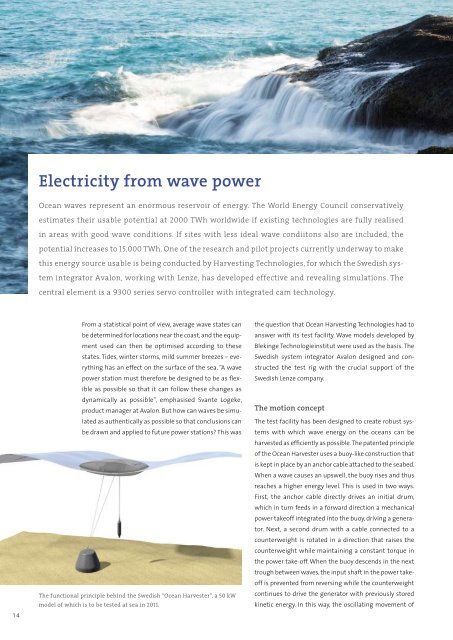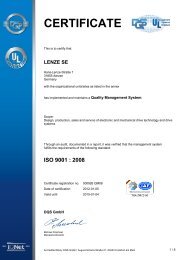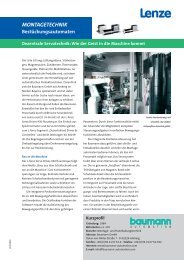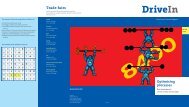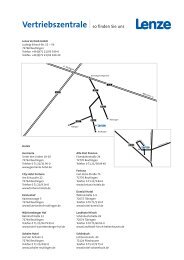Lenze's new international sales structure
Lenze's new international sales structure
Lenze's new international sales structure
You also want an ePaper? Increase the reach of your titles
YUMPU automatically turns print PDFs into web optimized ePapers that Google loves.
14<br />
Electricity from wave power<br />
Ocean waves represent an enormous reservoir of energy. The World Energy Council conservatively<br />
estimates their usable potential at 2000 TWh worldwide if existing technologies are fully realised<br />
in areas with good wave conditions. If sites with less ideal wave condiitons also are included, the<br />
potential increases to 15,000 TWh. One of the research and pilot projects currently underway to make<br />
this energy source usable is being conducted by Harvesting Technologies, for which the Swedish sys-<br />
tem integrator Avalon, working with Lenze, has developed effective and revealing simulations. The<br />
central element is a 9300 series servo controller with integrated cam technology.<br />
From a statistical point of view, average wave states can<br />
be determined for locations near the coast, and the equipment<br />
used can then be optimised according to these<br />
states. Tides, winter storms, mild summer breezes – everything<br />
has an effect on the surface of the sea. “A wave<br />
power station must therefore be designed to be as flexible<br />
as possible so that it can follow these changes as<br />
dynamically as possible”, emphasised Svante Logeke,<br />
product manager at Avalon. But how can waves be simulated<br />
as authentically as possible so that conclusions can<br />
be drawn and applied to future power stations? This was<br />
The functional principle behind the Swedish “Ocean Harvester”, a 50 kW<br />
model of which is to be tested at sea in 2011.<br />
the question that Ocean Harvesting Technologies had to<br />
answer with its test facility. Wave models developed by<br />
Blekinge Technologieinstitut were used as the basis. The<br />
Swedish system integrator Avalon designed and constructed<br />
the test rig with the crucial support of the<br />
Swedish Lenze company.<br />
The motion concept<br />
The test facility has been designed to create robust systems<br />
with which wave energy on the oceans can be<br />
harvested as efficiently as possible. The patented principle<br />
of the Ocean Harvester uses a buoy-like construction that<br />
is kept in place by an anchor cable attached to the seabed.<br />
When a wave causes an upswell, the buoy rises and thus<br />
reaches a higher energy level. This is used in two ways.<br />
First, the anchor cable directly drives an initial drum,<br />
which in turn feeds in a forward direction a mechanical<br />
power takeoff integrated into the buoy, driving a generator.<br />
Next, a second drum with a cable connected to a<br />
counterweight is rotated in a direction that raises the<br />
counterweight while maintaining a constant torque in<br />
the power take-off. When the buoy descends in the next<br />
trough between waves, the input shaft in the power takeoff<br />
is prevented from reversing while the counterweight<br />
continues to drive the generator with previously stored<br />
kinetic energy. In this way, the oscillating movement of


